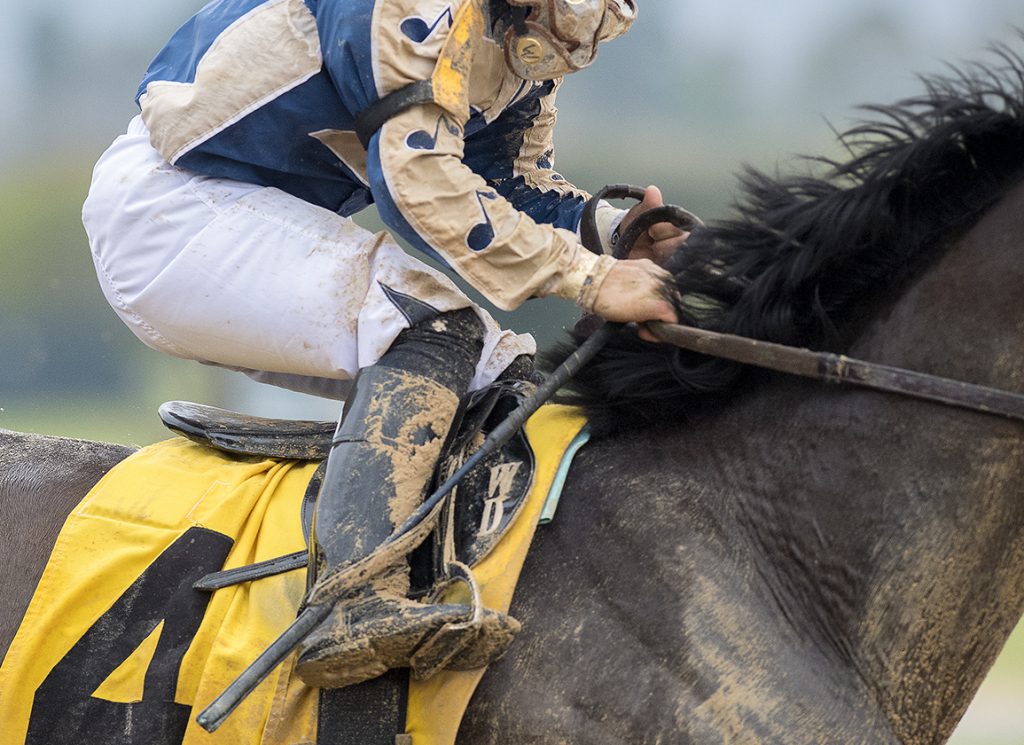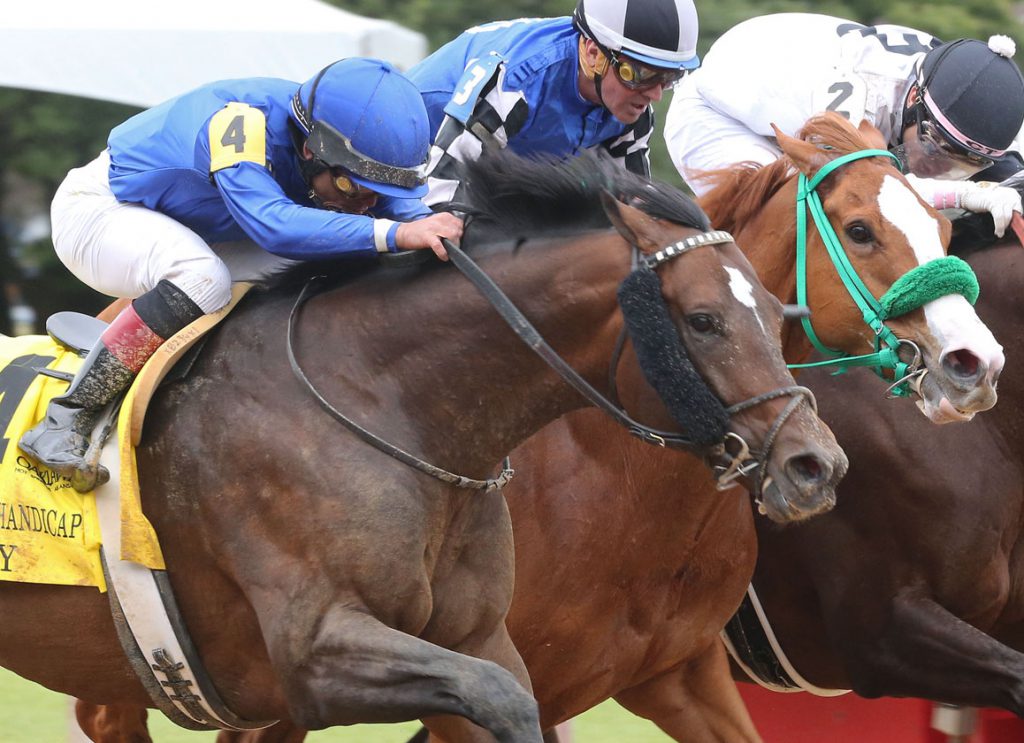Last week, the research team associated with StrideSAFE–a biometric sensor mechanism capable of detecting minute changes in a horse's gait at high speed–announced that seven of eight horses that suffered catastrophic musculoskeletal cases at Churchill Downs during its most recent meet showed via post-race readouts abnormalities as soon as they left the starting gate.
In a nearly two-hour town hall Monday morning, StrideSAFE founder David Lambert and Churchill Downs equine medical director Will Farmer dug into the details, discussing the findings from an ongoing study in Kentucky and fielding questions from horsemen.
Eric Hamelback, CEO of the National Horsemen's Benevolent and Protective Association (HBPA), kicked the town hall off by cautioning how fatal equine injuries can happen no matter the regulatory safety net in place.
“Regulations are not going to eliminate risk,” said Hamelback. “And quite frankly, we don't want regulations to eliminate horsemanship.”
Over the next two hours, Lambert made the case that StrideSAFE–which can pick up the sorts of very subtle lameness undetectable to the human eye that are significant enough to possibly cause major musculoskeletal failures at some point down the line–could, if utilized smartly, go a long way to reducing the number of horses injured on the track.
“I firmly believe the only way this problem is going to get solved is if we give the trainers the right kind of information and give it to them in time to give them a chance to do something,” he said, before alluding to the national attention focused on the recent spate of fatalities at Churchill Downs. As a result, the meet was transferred to Ellis Park.
“Right now, you guys are on a beating to nothing,” Lambert added.
As part of a study funded by the Kentucky Horse Racing Commission (KHRC) and in tandem with Washington State University, StrideSAFE has been used on all horses that have raced during the Churchill Downs spring 2023 meet, which concludes this Sunday. It has also been used on a select number of horses breezing during the morning.
In all, researchers have collected information from 6,616 individual runs.
The information is organized like a traffic light. A result in the red means there is a potentially major problem and immediate scrutiny of the horse is needed. An amber result suggests a small amount of change in the gait, and cautions connections to be on the lookout. A green result means there is no change and no immediate concern.
According to Lambert, about 5% of the horses studied were given the highest risk red-flag rating. These horses, he added, were about 300 times more likely to suffer a fatal injury than a horse green flagged.
As to how the technology works, StrideSAFE is a wireless iPhone-shaped device that fits snugly into the saddle towel, and eight hundred times a second, it takes an assortment of measurements to capture in minute detail the movement of the horse at high speed.
These measurements include the horse's acceleration and deceleration, the up-and-down concussive movement of the horse, and its medial-lateral motion–what is, in other words, the horse's movement from side to side.
“That's 2,400 data points every second your horse is running or breezing, so this is a massive amount of brand-new information that nobody has ever [received] before,” said Lambert.

Sarah Andrew
To understand exactly how StrideSAFE identifies almost imperceptible signs of lameness, it helps to break a single stride into three distinct stages.
In the first phase of the gallop, the hindlimbs load and propel the horse forward. In the second, the horse shifts its weight toward the front, its forelimbs acting like shock absorbers. This is followed by the lynchpin of the equation: A period of suspension, a mere fraction of a second, when the horse is entirely airborne.
If that horse is suffering a physical ailment or injury, it cannot adjust its body to compensate when its feet are grounded. It can only do this in midair, rotating its spine and pelvis in preparation for a more comfortable landing. Imagine a racecar hurtling along at high speed, one of its bolts working loose.
“The horse does all kinds of things in the air, twisting and shaking and moving,” Lambert had previously explained to the TDN.
In Monday's town hall, Lambert singled out the story of a horse that finished fourth in a Grade I event and showed no visible signs of lameness afterwards. The horse subsequently broke down over a week later during training.
“That sensor is screaming that the horse is in trouble,” said Lambert, highlighting abnormalities in a readout of the horse's high-speed gait during the race.
The town hall proved contentious at times, with some of the attending horsemen–many of whose concerns were voiced by Hamelback–sharing their frustrations that last week's announcement by the StrideSAFE researchers might have given the impression to the layman public that trainers should have known beforehand their horses were at risk.
Lambert apologized about the framing of the press release, all the while stressing how StrideSAFE could be an invaluable tool to catch potential problems early. The trick, explained both Farmer and Lambert, is to pair the StrideSAFE technology with a diagnostic follow-up to pinpoint the site of any brewing issue.
“It's not a diagnostic tool, it's a screening tool,” said Lambert,
Three red-flagged horses were subsequently scanned using the new PET imaging unit at the Rood and Riddle Equine Hospital in Kentucky, according to Denise McSweeney, a co-investigator in the study.
Lambert also admitted that the information collected from StrideSAFE paints far from a complete picture.
Not all the horses given a high-risk red-flag designation will suffer a fatal injury, for example. That's because in part, the horse's stride can be affected by things like the motion of the jockey and by stumbles out of the gate.
Furthermore, “very occasionally, a green-flagged horse will go down,” said Lambert.
But the current inconsistencies in data interpretation are outweighed by the high rate at which the technology identifies potentially at-risk horses, he argued.
“If there's a chance you'll save a jockey from being paralyzed, it's worth doing,” said Lambert, adding how greater use of StrideSAFE would aid in researchers and clinicians getting a better baseline understanding of what the data means.
Attendees also raised data privacy concerns. According to Farmer, the study results are not shared with the KHRC. Rather, the information is sent to Washington State University, where Warwick Bayly is the lead investigator.
In certain cases, the panelists explained, researchers have followed up with the horse's connections directly.
The Horseracing Integrity and Safety Authority (HISA) is not affiliated with the program.
The ongoing Kentucky study marks just the latest StrideSAFE trial to show promising results.
Of the 20 horses that suffered fatal musculoskeletal injuries during the period of a trial involving the New York Racing Association (NYRA), 17 of them had received a red rating in a race before suffering a catastrophic breakdown. One of the 20 had received a prior dark amber rating.
“Really what my sensor is doing is helping horsemanship,” Lambert said on Monday. In racing's ongoing quest to reduce equine injury and harm, he added, “This could be the answer horsemen are looking for.”

The post StrideSAFE Town Hall in Kentucky: “This Could Be the Answer Horsemen Are looking For” appeared first on TDN | Thoroughbred Daily News | Horse Racing News, Results and Video | Thoroughbred Breeding and Auctions.
Source of original post


